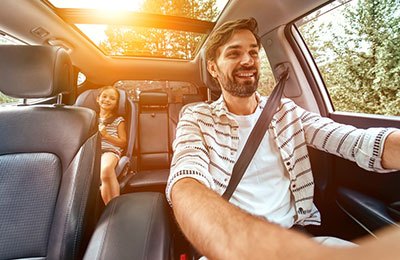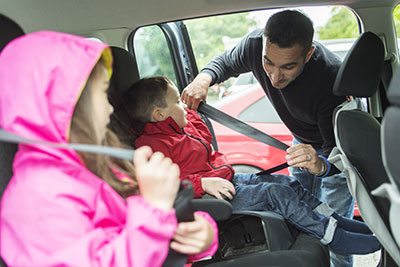Are you a parent looking to buy a new car? In 2023, there are more safety options available than ever before.
From side airbags to parking assist sensors, it can be overwhelming to figure out what features will keep your family safer in the event of an accident. One such technology gaining traction is built-in child car seats and built-in booster seats – but are built in car seats legal?
With so many conflicting opinions and information out there, we decided to create this 2023 Car Seat Safety Guide that compiles up-to-date rules governing child restraints in each state and provides advice from experts so you can make informed decisions about the type of car seat that best suits yours and your child's needs.
More...
Take Away Key Points:
What are build-in car seats?

Build-in car seats are a common feature in many modern vehicles. They offer a variety of advantages over traditional car seats, such as being permanently attached to the vehicle and providing increased safety features.
Build-in car seats also come with adjustable headrests and lumbar support for greater driving comfort. Additionally, they often have extra storage capabilities for items like toys or groceries. To use these seats, a compatible model must be adequately installed according to manufacturer instructions.
Dodge set the trend for built-in car seats
In the 1990s, Dodge released the Caravan with an innovative feature: a built-in child seat that folds down from the middle seat for easy access. This was a groundbreaking concept at the time, and since then, other car makers have followed suit, including built-in booster seats in their vehicles' designs.
More recently, Volvo released a luxury concept with an adjustable rear-facing infant seat featuring amenities such as a storage drawer, built-in bottle holder, and warmer.
1. Are they safe?
The safety of built-in car seats is paramount for drivers and passengers. Thankfully, these seats come with various features that help make them reliable. For example, most vehicles come with adjustable headrests, lumbar support for additional comfort, and extra storage compartments for toys and other items. They are also generally easier to install correctly than traditional car seats, which further adds to their level of safety.
Additionally, they remain firmly in place when properly installed, so children do not have to worry about the seat becoming disconnected or jarred during travel. Overall, built-in car seats provide an excellent means of keeping children safe while on the road.
The location of these integrated seats is, however, not always that safe. Although it depends on the vehicle manufacturers and car models, most of these seats are behind the driver or in the center seat in the middle of two outside rear seats.
2. Advantages of using an integrated car seat
Integrated car seats offer numerous benefits, making them an ideal choice for traveling with children. Some of these advantages include:
- Convenience: Integrated car seats are easy to use and can be safely installed in a matter of minutes.
- Comfort: These seats come with adjustable headrests, lumbar support, and other amenities to keep kids comfortable during long trips in the car.
- Safety: When properly installed, built-in booster seats remain firmly in place and help protect kids from potential accidents and injuries on the road.
- Cost-efficiency: Many models come at a very affordable price, so you don't have to worry about spending too much on quality protection for your little ones.

3. Disadvantages of using an integrated car seat
Though integrated car seats are generally safe and convenient, there are some potential drawbacks that drivers should be aware of.
- Limited use: Many integrated car seats only accommodate children over a certain age or weight, so they may not be suitable for bigger kids and toddlers. The booster cushion seat is not suitable for the installation of infant seats or rear-facing position seats. Additionally, you cannot install a forward-facing car seat over the integrated seats as well.
- Limited choices: Limited choices regarding features and colors of the integrated seat compared to other types of car seats.
- Location: Volvo is the only car with a built-in booster seat. However, the problem occurs with the location of these child seats. All of their built-in booster seats are located in the front of the car, close to the passenger airbag. As a result, the deployment of the airbag could harm smaller children.
- Safety & Mobility issue: Difficult to move around due to the integrated seat not being removable, meaning it cannot be attached to a stroller or cart. In the event of an accident, first responders cannot remove the entire seat as quickly, which could potentially cause harm to the child's neck or spine.
- Lack of five-point harness: The lack of five-point harness slots is a disadvantage, especially for small children using integrated seats. Although many parents would switch their children to using a booster seat when they reach weight limits, many children are not yet ready for seat belt rides.
4. What car models come with a built-in car seat?
Did you know that although there are no cars with a built-in rear-facing or convertible car seat, many car models come with a built-in booster seat?
They are popular choices for extra child safety features since children can outgrow infant carriers quickly, and parents don't always want to keep purchasing these for their growing babies.
These booster seats provide added protection for older kids in a crash, compared to using just a regular seat belt alone, and they are mainly located in the back seat.
However, you need to be careful when transitioning from a convertible seat to a booster, making sure your child outgrows the previous seating position completely.
All of these models exceed current safety standards, so parents can rest assured that their children have the best possible protection in nearly any vehicle.
Keep in mind that while these built-in booster seats provide added convenience, they won't be suitable for all children - so it's important to check weight and height recommendations before purchasing. Also, before letting your children ride in the built-in booster seat, check the car seat manual first.
The following cars come with an integrated booster seat:
- Volvo XC90: The Volvo XC90 integrated booster seat is designed to provide a comfortable and secure seating experience for children aged 4 to 10 years old.
- Volvo Dodge Journey (select models): The Dodge Journey (select models) comes with two built-in booster seats designed for children 48-89 pounds of the maximum weight limit. The seat also has an additional belt adjustment feature, which allows you to adjust the tightness of the safety belt depending on your child's size.
- Volvo V60: This child seat, combined with the car's seatbelt, is designed to keep your child safe and secure. It comes with adjustable cushion heights for two different weight cohorts (15 - 36 kg) and a minimum height requirement of 95 cm. This ensures it is suitable for your child regardless of size and weight.
- Volvo XC60: This child seat is designed to keep your child safe while traveling with the car's seatbelt. It is suitable for children weighing 15 - 36 kg (33 - 80 lbs) and having a height of at least 95 cm (37 inches). The seat cushion can be adjusted into two different positions as per the child's weight. Volvo recommends that parents travel with their children in a rear-facing child seat until as late as possible, preferably up to 4 years old.
- Volvo V90 Cross Country: This child seat, along with the car's seatbelt, is designed to keep your little ones safe and secure. It has adjustable cushion heights for two different weight groups (15 - 36 kg) and a minimum height requirement of 95 cm. This ensures that the seat is suitable for children regardless of size or weight. In addition, the car model is equipped with two integrated booster seats.
- Volvo XC70: The integrated booster seats in the car's rear seat ensure children are comfortable and safe. These unique cushions provide overall safety when combined with the shoulder belt for kids aged between 15 to 36 kg and with a minimum height of 95 cm.
Booster seat requirements

Booster seats are an essential life-saving tool designed to provide optimal protection for children when riding in cars.
Depending on the state, booster seat requirements are based on a child's age, weight, and height. For example, some states require kids ages 6 through 8 to sit in a booster seat until their height exceeds 4 feet 9 inches. Moreover, many cities even have additional ordinances, including booster seats for older kids who do not meet specific criteria.
Depending on where you live and your child's age, it may be required to use a particular booster seat or combination with a harness.
By following these regulations, parents can ensure their children's safety while riding in cars and promote proper seat belt usage, essential for protecting passengers during a crash.
FAQs
Do built-in car seats expire?
Integrated child seat does not have an expiry date. However, it is recommended that they are regularly inspected for signs of wear and tear.
In some cases, manufacturers may guide you on how long the seat should be used before replacing it. It is important to follow these instructions to ensure your child's safety.
Are built-in car seats safe?
Built-in car seats are commonly considered safe due to their quality construction and ability to attach securely to the seat.
That being said, it is important that they are inspected regularly for signs of wear and tear, and the manufacturer's instructions should be followed to ensure your child's safety.
What age does my child have to be to ride in a built-in booster seat?
Children under the age of 12 should use a built-in booster seat.
Depending on the size and weight of your child, it is recommended that they ride in a backless booster seat until they are 4-8 years old or weigh more than 40 pounds.
Additionally, most states have laws regarding car seat requirements, so be sure to check your local regulations before taking your child for a ride.
Which SUVs have built-in car seats or booster seats?
Currently, Volvo is the only car company that offers integrated booster seats.
Which Volvo has a built-in car seat?
Built-in car seats are available in cars such as Volvo XC90, Dodge Journey (select models), Volvo V60 (2018 model), Volvo XC60, Volvo V60 (2018 model), and Volvo V90 Cross Country.
Final Words
Built-in car seats for children provide the necessary safety measures to protect kids and give parents peace of mind.
These seats are designed with special features that keep small passengers secure and comfortable, offering a safe and secure way to travel.
With a wide range of models available, there's sure to be one that fits any family's needs and budget perfectly.

Hi! We recently purchased s 2008 dodge grand caravan with integrated seats. Are these also considered safe still?